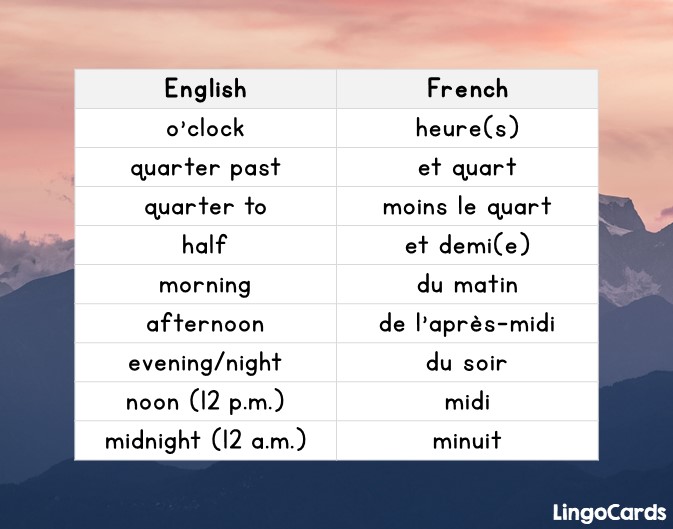
If you are learning French, telling the time is definitely an important skill you should have. Here we provide you with these eight simple rules to tell time in French.

1st Rule – Know the Numbers
To begin with, you have to be familiar with numbers in French – at least from one to 59.
2nd Rule – Asking the Time
For asking the time, use the phrase:
Quelle heure est-il?
What time is it?
3rd Rule – Telling the Time
When someone asks you, “Quelle heure est-il?”, you can respond with:
Structure: Il est + [number] + heure(s)
Examples:
Il est une heure.
It is one o’clock.
1h00
Il est deux heures.
It is two o’clock.
2h00
Il est trois heures.
It is three o’clock.
3h00
and so on.
Here are a few notes to take before you continue:
- As one is singular, we use heure. Except one, we use heures – they are plural.
- Use une instead of un for expressing 1 o’clock – the word heure is feminine.
- In a casual conversation, you can omit the il est (it is), but not the heure(s) [hour(s)]. Well, this rule does not apply for midi (noon) and minuit (midnight) though – you do not use the word heure behind midi (noon) and minuit (midnight).
- We do not use the colon (:) to separate hour and minutes in French. Instead, substitute the colon with the letter ‘h’ [for heure(s)].
4th Rule – Add the Minutes after Heure(s)
If the time is not exactly number + o’clock, add the minutes after heure(s). That’s it.
Structure: Il est + [number] + heure(s) + [number]
Examples:
Il est six heures dix.
It is six past ten.
6h10
Il est huit heures quarante.
It is eight past forty.
8h40
5th Rule – Quarter, Half, and To
For expressing ‘quarter past’, use et quart, which literally translated as ‘and a quarter’.
Il est cinq heures et quart
It is quarter past five.
5h15
And for ‘quarter to’ add moins le quart, which literally translated as ‘minus a quarter’.
Il est sept heures moins le quart.
It is quarter to six.
5h45
The same rule applies for ‘[number] minutes to’ – add moins [number].
Il est sept heures moins cinq.
It is five to six.
5h55
If you want to say ‘half’ or ‘past 30 minutes’, say et demie, which literally translated as ‘and a half’.
Il est quartre heures et demie.
It is half past four.
4h30
6th Rule – 24-hour System
Rather than getting around using a.m. or p.m. time, it is more common to use the 24-hour system.
Therefore:
Il est quatorze heures.
It is two p.m.
14h00
Il est vingt heures.
It is eight p.m.
20h00
With the 24-hour system, you only need to use the actual number for the minutes. Leave out the et quart, moins le quart, moins [numbers] and et demie.
Thus:
Il est quinze heures quarante-cinq.
It is quarter to four p.m. (3:45 p.m.)
15h45
7th Rule – 12-hour System
It is still acceptable to use the 12-hour system though. However, you need to differentiate whether it is nine a.m. or nine p.m. While there is no direct translation of a.m. and p.m. in French, du matin (morning), de l’après-midi (afternoon), and du soir (evening/night) are here to help!
Thus:
Il est neuf heures du matin.
It is nine a.m.
9h00
Il est neuf heures du soir.
It is nine p.m.
21h00
By using the 12-hour system, use the complete et quart, moins le quart, moins [numbers] and et demie; along with du matin, de l’après-midi and du soir.
Examples:
Il est onze heures moins le quart du matin.
It is quarter to eleven a.m (10:45 a.m.)
10h45
Il est une heure moins cinq de l’après-midi.
It is five to one p.m (12:55 p.m).
12h55
8th Rule – Noon and Midnight
Instead of saying “Il est douze heures” for noon and midnight, we use midi and minuit, respectively.
Thus:
Il est midi.
It is noon.
12h00
Il est minuit.
It is midnight.
00h00
You can also add minutes behind midi or minuit.
Thus:
Il est midi quinze.
It is quarter past noon.
12h15
If you want to add half (30 minutes) behind midi or minuit, use et demi (without the letter ‘e’).
Therefore:
Il est minuit et demi.
It is half past midnight.
00h30
Let’s learn French today! Join us at LingoCards!